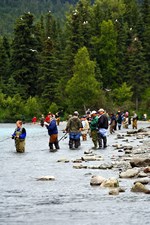 The Trustee Council has funded the development of a technique to rapidly identify different stocks using genetic information. This is another example of how an increase in knowledge - in this case genetic sampling - can translate into a tool that can be used to refine fisheries management and better inform fisheries management decisions.
The Trustee Council has funded the development of a technique to rapidly identify different stocks using genetic information. This is another example of how an increase in knowledge - in this case genetic sampling - can translate into a tool that can be used to refine fisheries management and better inform fisheries management decisions.
In 1998 the return of sockeye salmon to the Kenai River was significantly lower than expected. Fisheries managers reduced the sport-catch limit on the Kenai and severely restricted commercial fishing. In order to reach minimum-escapement goals for key tributaries of the Kenai River, such as the Russian River, biologists faced a decision about closing the sport fishery altogether. In response fisheries managers ordered genetic sampling of the sockeye entering the river to identify which stock was entering the River, or if it was a mix of both the Kenai and Russian River stocks. Within three days, they had documented that escapement goals to the Russian River tributary would be met and they could keep this popular fishery open. Without the genetic sampling method, developed with funds from the Trustee Council, fisheries managers would have been forced to close the sport fishery in order to protect a stock that was erroneously suspected to be depleted. The genetic sampling technology quickly provided more accurate data to use in the management of this vital fishery.
